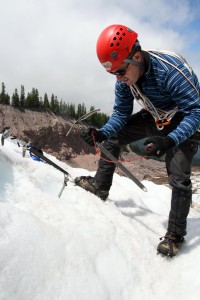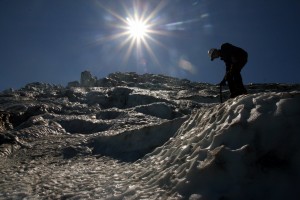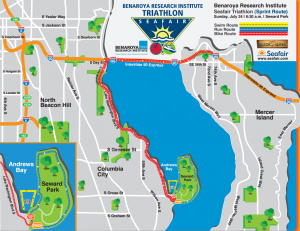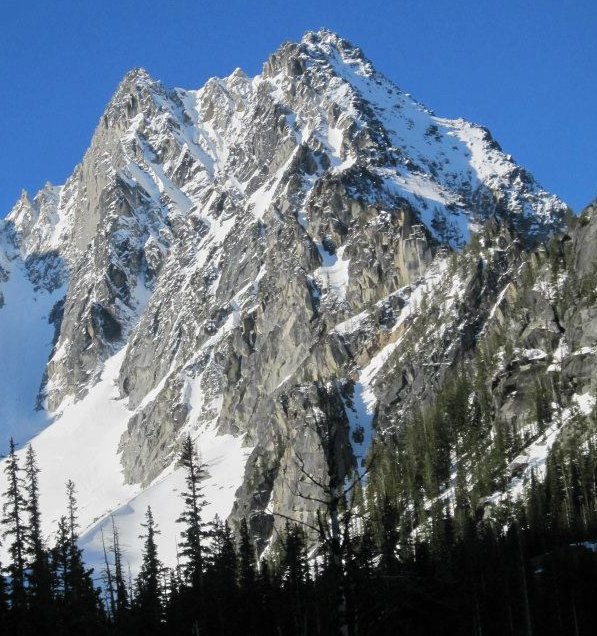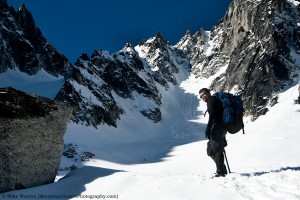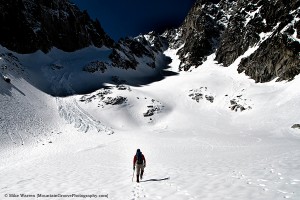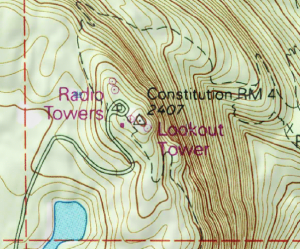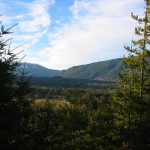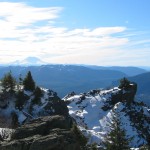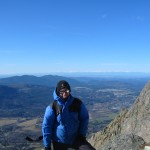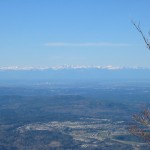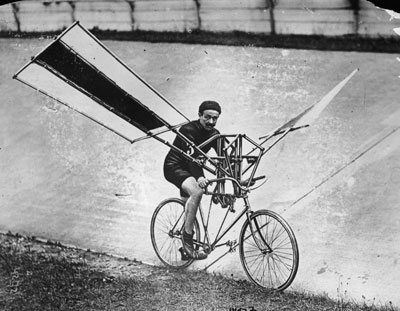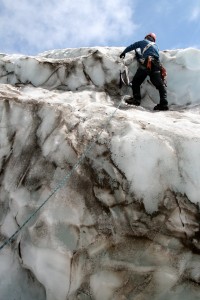 Ice I is where the Seattle Mountaineers’ Intermediate Course first addresses ice climbing. I’ve top-roped water ice many years ago in the Adirondacks and New Hampshire, and did some alpine-style ice climbing in Wyoming during my NOLS trip, but this was the first time climbing ice here in Washington.
Ice I is where the Seattle Mountaineers’ Intermediate Course first addresses ice climbing. I’ve top-roped water ice many years ago in the Adirondacks and New Hampshire, and did some alpine-style ice climbing in Wyoming during my NOLS trip, but this was the first time climbing ice here in Washington.
I’m not devoted enough to ice climbing to buy modern, bent-shaft ice tools. Particularly for around here, there’s just not really any water ice where they’d be necessary. The ice we do have is usually on glaciers and is rarely vertical for more than a few feet. Thus I bought a used straight-shaft ice tool from a buddy and decided to use my normal ice axe as my second tool.
The problem is that an ice axe really just doesn’t work for climbing anything approaching vertical – it is just too long, and the head is too light to get a good placement without a lot of work. My new tool, however, worked wonders – it went in really easily and felt solid each time. I actually liked it more than some of the bent-shaft tools I tried, but the price you pay is sometimes crushing your fingers against the ice. Also, the thing weighs a ton. But if I knew I was going to be encountering steep ice, I’d probably opt to bring two such tools, since you can still self-arrest with them as with a normal ice axe (though I’ve never tried this).
It was sunny that day on Baker, so we were continuously having to check the screws. Because ice screws are metal and conduct heat, they have a tendency to melt out the underlying ice if the sun hits them, compromising their security. I borrowed some of the old style Russian titanium screws – although some climbers swear by them because they’re so light, I found them to be a bit of a pain since they don’t have the modern rotating knob that makes placing modern ice screws so fast and easy.
We also practiced making V-threads. I had a bit of trouble with this, as I several times couldn’t get the holes I drilled in the ice to meet up. I think V-threads are a bit scary – I’d always want to back them up with screws on a rappel and have the lightest person (most likely not me!) pull the screws and go down solely on the V-thread.
One of the best parts of being on alpine ice is the beautiful shapes and sculptures that the water, wind, and sun carve out. Often, these form rivers in the glacier that are like waterslides. Other times the water flows deeper into the glacier and makes big caverns (indeed, one of the guys dropped a carabiner down one by accident…they’ll probably find that a few centuries from now when the glacier recedes up the mountain).
So I’m fine climbing on steeper ice, but I still have no real desire to do sport-style vertical ice climbing. It’s just not something that really interests me – besides, ice climbing packs are really heavy!
The photos are courtesy of Michael Rosenthal, who I now know drops gear both on rock and ice routes…
Mt. Baker Ice I Field Trip
[img src=https://www.ehrenbrav.com/wp-content/flagallery/mt-baker-ice-i-field-trip/thumbs/thumbs_img_9724.jpg]20960
[img src=https://www.ehrenbrav.com/wp-content/flagallery/mt-baker-ice-i-field-trip/thumbs/thumbs_img_9730.jpg]20540
[img src=https://www.ehrenbrav.com/wp-content/flagallery/mt-baker-ice-i-field-trip/thumbs/thumbs_img_9737.jpg]20200
[img src=https://www.ehrenbrav.com/wp-content/flagallery/mt-baker-ice-i-field-trip/thumbs/thumbs_img_9754.jpg]19890
[img src=https://www.ehrenbrav.com/wp-content/flagallery/mt-baker-ice-i-field-trip/thumbs/thumbs_img_9758.jpg]19580
[img src=https://www.ehrenbrav.com/wp-content/flagallery/mt-baker-ice-i-field-trip/thumbs/thumbs_img_9762.jpg]19420
[img src=https://www.ehrenbrav.com/wp-content/flagallery/mt-baker-ice-i-field-trip/thumbs/thumbs_img_9763.jpg]19240
[img src=https://www.ehrenbrav.com/wp-content/flagallery/mt-baker-ice-i-field-trip/thumbs/thumbs_img_9766.jpg]19060
[img src=https://www.ehrenbrav.com/wp-content/flagallery/mt-baker-ice-i-field-trip/thumbs/thumbs_img_9779.jpg]18960
[img src=https://www.ehrenbrav.com/wp-content/flagallery/mt-baker-ice-i-field-trip/thumbs/thumbs_img_9796.jpg]18750
[img src=https://www.ehrenbrav.com/wp-content/flagallery/mt-baker-ice-i-field-trip/thumbs/thumbs_img_9797.jpg]18670
[img src=https://www.ehrenbrav.com/wp-content/flagallery/mt-baker-ice-i-field-trip/thumbs/thumbs_img_9799.jpg]18520
[img src=https://www.ehrenbrav.com/wp-content/flagallery/mt-baker-ice-i-field-trip/thumbs/thumbs_img_9800.jpg]18450
[img src=https://www.ehrenbrav.com/wp-content/flagallery/mt-baker-ice-i-field-trip/thumbs/thumbs_img_9801.jpg]18340
[img src=https://www.ehrenbrav.com/wp-content/flagallery/mt-baker-ice-i-field-trip/thumbs/thumbs_img_9808.jpg]18220
[img src=https://www.ehrenbrav.com/wp-content/flagallery/mt-baker-ice-i-field-trip/thumbs/thumbs_img_9810.jpg]18180
[img src=https://www.ehrenbrav.com/wp-content/flagallery/mt-baker-ice-i-field-trip/thumbs/thumbs_img_9833.jpg]18020
[img src=https://www.ehrenbrav.com/wp-content/flagallery/mt-baker-ice-i-field-trip/thumbs/thumbs_img_9838.jpg]18010
